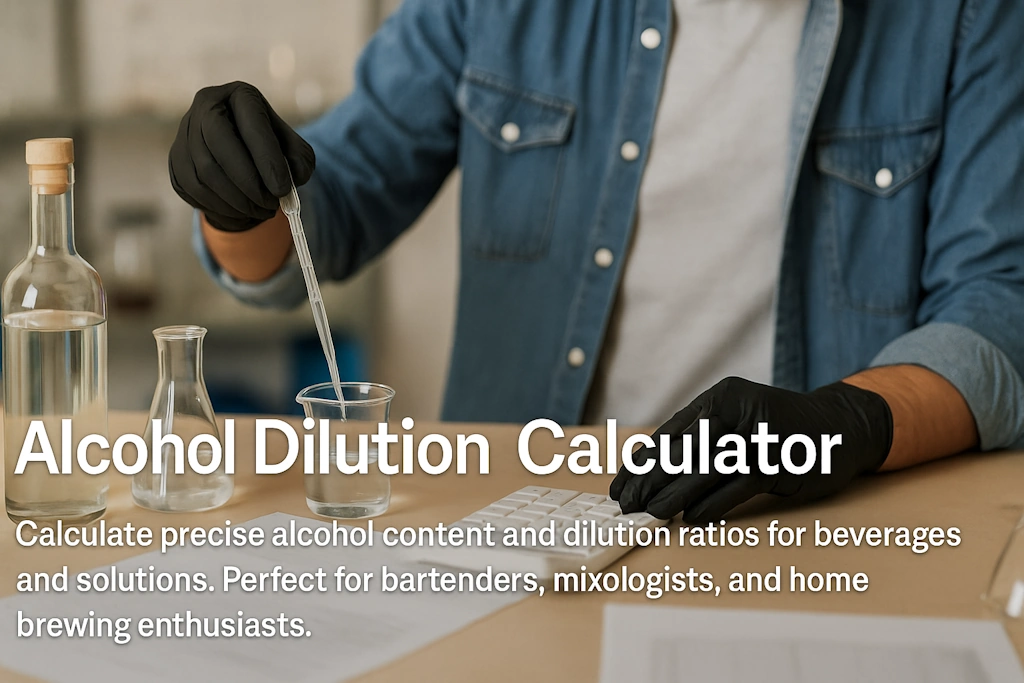Alcohol Dilution Calculator | ABV for Cocktails

Tell us more, and we'll get back to you.
Contact Us
Tell us more, and we'll get back to you.
Contact UsEmbed on Your Website
Add this calculator to your website
Alcohol dilution combines chemistry and mixology in fascinating ways. When you mix spirits with other ingredients, you're engaging in precise science dating back to the 1800s. Professional bartenders have always carefully balanced alcohol content for taste, potency, and safety, drawing on both tradition and scientific principles.
When we mix alcoholic beverages, ethanol (C₂H₅OH) molecules distribute evenly throughout the liquid. The final alcohol by volume (ABV) is determined by the ratio of alcohol to total volume. Unlike many chemical mixtures, alcohol and water create an "ideal solution" where volumes are approximately additive, with minimal contraction.
Final ABV: Total Alcohol Volume / Total Liquid Volume × 100%
Total Alcohol: Σ(Volume of Spirit × ABV% / 100)
Dilution Factor: Original ABV / Final ABV
| Beverage Type | Typical ABV Range | Notes |
|---|---|---|
| High-proof Spirits | 50-75% | Overproof rum, absinthe |
| Standard Spirits | 35-50% | Vodka, gin, whiskey, tequila |
| Liqueurs & Cordials | 15-30% | Balanced for sweetness |
| Fortified Wines | 16-24% | Port, sherry, vermouth |
| Table Wine | 11-14% | Red, white, rosé |
| Beer | 4-8% | Varies by style |
| Low-alcohol options | 2-5% | Spritzers, hard seltzers |
When mixing alcoholic beverages, the final ABV isn't a simple average because the calculation needs to account for the total volume of alcohol relative to the total mixture volume. This is why our calculator uses precise volumetric calculations.
While temperature can slightly affect alcohol concentration measurements, this calculator assumes standard room temperature (20°C/68°F). For most practical purposes, these variations are negligible.
Yes, this calculator works for any alcoholic beverage as long as you know the ABV (Alcohol By Volume). It can be used for beer, wine, spirits, or any mixture of alcoholic beverages.
The calculator provides results to one decimal place, which is suitable for most practical applications. For commercial or laboratory purposes, you may need specialized equipment for more precise measurements.
Ice dilutes cocktails by approximately 20-25% during proper mixing. The calculator doesn't account for ice dilution automatically, so you'll need to estimate and add the resulting water volume as a non-alcoholic mixer.
Yes! Use the "Calculate Mixer Needed (Target ABV)" mode to determine exactly how much non-alcoholic mixer you need to achieve your desired alcohol content. This is particularly useful for batching cocktails and ensuring consistency.
Select any cocktail preset from the dropdown to automatically populate the ingredients with typical proportions for classic cocktails like Margarita, Old Fashioned, Manhattan, and Mojito. You can then adjust the volumes to your preference.
ABV (Alcohol By Volume) is the percentage of liquid volume that is ethanol. Proof is typically twice the ABV in the US (e.g., 80 proof = 40% ABV), but varies by country. This calculator uses ABV, which is the international standard.
Absolutely! The calculator works for any volume. For large batches, multiply all ingredient volumes proportionally. Remember to account for ice dilution if serving immediately, or pre-dilute by 20-25% if bottling.
Bitters typically contain 35-45% ABV but are used in very small quantities (dashes). For precision, add them as ingredients. Garnishes like orange peels or cherries have minimal impact on ABV and can be ignored.
Legal limits vary by jurisdiction. Many places limit cocktails to 2-3 standard drinks (28-42ml pure ethanol). Always check local regulations and serve responsibly. Our calculator helps ensure compliance with serving standards.
Yes, but note that heating alcohol can cause some evaporation, slightly reducing ABV. The calculator assumes no evaporation. For hot drinks, consider the initial ABV before heating as a reasonable approximation.